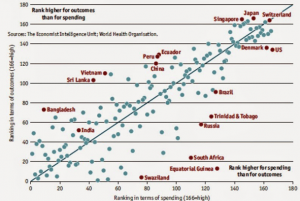2016 is shaping up to be an exciting year for providers of medical travel (or is it medical tourism?).
Medical Travel Quality Alliance expects that these will be the trends and issues of 2016 for the medical tourism industry, and will affect nearly all segments of the industry in nearly all countries around the globe.
1. Medical tourism gives birth to a baby boom.
The demand by medical tourists for in vitro fertilization IVF, gender selection, commercial surrogacy, and birthing places keeps growing.

After Thailand and India restricted commercial surrogacy, some surrogacy agencies moved operations to Cambodia and Nepal. In late 2015, Nepal and Mexico – which had allowed commercial surrogacy in the state of Tabasco – made surrogacy illegal.
But this doesn’t stop demand.
Surrogacy tourism to Russia, Ukraine and Georgia where commercial surrogacy is not restricted is likely to grow. Canada and the US may also benefit from this.
The China effect
Since the Chinese government removed its one-family one-child policy last year, many Chinese parents will want more children. Their need for IVF services and commercial surrogacy – neither of which are trusted services at home – and foreign birthright may create a medical tourism baby boom.
Chinese medical tourists are already the single largest group using birthright tourism and prefer the US, Hong Kong and Canada to give birth. Anchor babies is the term used for children purposely born in a foreign country that gives citizenship as a birthright. Among the countries that do this are the United States, Canada, Argentina, Brazil, Mexico, Peru and at least 20 others.
In the future, we can expect medical tourist interest in three-person embryo procedures pioneered by the UK and the US.
2. As medical tourism facilitators, agents and brokers fail, hospitals do more checks and review of their partnerships.
Recent bankruptcies, rumors of scandal and FBI investigations, charges of patient trafficking add fuel to the fire for those with poor views of the medical tourism industry. Yet these are not reasons to avoid medical travel. These are reasons to be more careful in choosing facilitators and providers.
Satori World and Planet Hospital
 Satori World Medical, Inc., hailed by some as medical tourism’s poster child, is no longer. Despite so-called patents on medical tourism related processes and contracts with US companies to provide employee medical travel, Satori World Medical has gone out of business.
Satori World Medical, Inc., hailed by some as medical tourism’s poster child, is no longer. Despite so-called patents on medical tourism related processes and contracts with US companies to provide employee medical travel, Satori World Medical has gone out of business.
The company’s bankruptcy filing in December 2015 in California courts shows it owes more than one million dollars to at least 17 creditors.
Another poster child, Planet Hospital, is now a shadow of its former self. The company, and its colorful founder Rudy Rupak, had wide exposure in many leading newspapers, magazines and media outlets around the world for several years. Rupak was a frequent speaker at conferences.
In 2014 Planet Hospital and Rupak were charged by former clients of misusing tens of thousands of dollars, abandoning surrogates and leaving a trail of unpaid bills, according to Australia’s ABC News. Today, Rupak is back in the tech business.
3. Medical tourism enters the halls of academe.

Universities and technical institutes in countries across Europe, Asia and North America, and major global organizations, are looking for ways to include the practical study of medical tourism in their educational programs.
Gulf Medical University and MTQUA
Gulf Medical University in Ajman, UAE is one of the first institutions of higher learning to put medical tourism content and courses into its curriculum. With input from MTQUA, GMU expects to one day be able to offer certificate and diploma programs that meet its rigorous standards.
Other college programs, notably at Florida International University, have tried but failed to do this in the past. The medical tourism industry is watching the GMU program with great interest.
4. The search for new medical travel “hot spots” goes on.
 As the US lifts the veil on Cuba, medical tourism promoters and bloggers are already busy with claims that this Caribbean island nation has great treatment choices for medical travelers.
As the US lifts the veil on Cuba, medical tourism promoters and bloggers are already busy with claims that this Caribbean island nation has great treatment choices for medical travelers.
Cuba may offer a select few procedures but does not qualify as a destination to be sought out by travelers for medical or dental treatment or surgery.
Reportedly, drugs are in short supply in Cuba, or are outrageously expensive. Medical equipment is often old and state-of-the-art equipment is rare.
Basic supplies like chlorine for disinfectant and surgical gloves reportedly are scarce. Hospital furnishings are modest at best.
Medical treatment in Cuba
Drug and alcohol addiction treatment is available for international patients, thanks to the work of Dr. Ricardo Gonzalez, an internationally recognized expert on addictions. Certain non-invasive procedures such as physical therapies that require extensive daily exercise and treatment but not necessarily highly sophisticated knowledge or equipment are worth investigating.
Desperate medical tourists looking for solutions to conditions that have no proven or accepted cures may be tempted to think they have found them in Cuba. Whether it’s an experimental surgery for the inherited eye condition retinitis pigmentosa, unproven stem cell treatments, or other alternative therapy, vulnerable travelers may find themselves victims of unscrupulous or naive medical travel facilitators promoting unproven or questionable procedures.
Iran
In similar fashion, as international sanctions are being removed, Iran may receive more attention as a medical travel destination. Yet international and domestic uncertainty continues to check the enthusiasm of Iran’s medical professionals to grow a medical tourism industry. With such a fluid situation, medical tourists traveling to Iran, from Libya, Syria etc., need to take care when seeking medical services. Iran needs to improve its business environment and infrastructure, show government and professional support, and demonstrate commitment to quality and safety of clinical procedures and care services.
Cayman Islands
One stellar example stands in contrast to the above. The Cayman Islands – a British overseas territory in the Caribbean – has taken a different route to medical tourism. With limited health care resources, the local government provided tax breaks and other incentives for the development of Health City Cayman Islands (HCCI), which opened in 2014 and is a joint venture between the US Ascension Healthcare and Dr. Devi Shetty, founder of Narayana Health, one of India’s leading heart hospitals.
Its success may show how places like the Bahamas, Jamaica, and Puerto Rico can add medical travel health as an attraction and economic growth engine.
5. Will 2016 be the year when the medical tourism industry becomes the medical travel industry?
 Is it medical tourism or is it medical travel?
Is it medical tourism or is it medical travel?
The question just won’t go away. It was a topic at the first international medical travel conference in 2006, and it still comes up regularly at every medical tourism conference.
One frequently hears, It’s not medical tourism, it’s medical travel. Industry practitioners – facilitators and agents, doctors, hospital managers – will argue and defend their use of the phrase medical travel. They see this industry first as providing medical intervention and second – often a distant second – as offering tours and holidays.
One rarely hears, It’s not medical travel, it’s medical tourism.
6. Traditional government-sponsored outbound medical tourism pulls back.
In 2008 and 2009, during the global recession, Dubai, Saudi Arabia and other countries that traditionally outsourced health care cut their budgets and sent less citizens abroad for medical treatment. Suddenly, lobbies and waiting rooms in hospitals like Thailand’s Bumrungrad International emptied of medical travelers.
 In 2016, budget cuts are not the only reason that some countries are financing less medical travel. Governments sponsoring outbound medical tourists are reviewing their medical travel budgets, putting more restrictions on medical travel, searching for alternative destinations, and demanding better clinical outcomes.
In 2016, budget cuts are not the only reason that some countries are financing less medical travel. Governments sponsoring outbound medical tourists are reviewing their medical travel budgets, putting more restrictions on medical travel, searching for alternative destinations, and demanding better clinical outcomes.
This is happening because:
- Lower oil prices mean there is less money in the oil-producing countries that have been traditionally sources of outbound medical tourists.
- There are more good hospitals in alternative destinations (Malaysia instead of Singapore, India instead of Thailand, etc.).
- Uncertainty is growing about the quality of care, especially availability of critical drugs in areas affected by war and terrorism .
- Clinical outcomes and other troubles of returning medical tourists are being more closely tracked.
- Some governments want to encourage more use of their own newly developed local health care infrastructure.
7. To regulate or not to regulate the medical tourism industry?
Calls for “cleaning up” of the medical tourism industry are more widespread, coming from many corners of the globe.
 MTQUA, in its first ever Medical Travel Advisory, alerts medical tourists that medical travel to five countries – Dominican Republic, India, Mexico, South Korea and Thailand – poses more risk to safety and quality. Regulations – new or old – mean little if not enforced. MTQUA challenges government and medical bodies to take charge of the situation and be responsible for better safety and quality of treatment of medical travelers.
MTQUA, in its first ever Medical Travel Advisory, alerts medical tourists that medical travel to five countries – Dominican Republic, India, Mexico, South Korea and Thailand – poses more risk to safety and quality. Regulations – new or old – mean little if not enforced. MTQUA challenges government and medical bodies to take charge of the situation and be responsible for better safety and quality of treatment of medical travelers.
Mixed messages of certification
Medical tourism certification may be a good start on the road to supervision, standards, and accountability. But it still has a way to go.
 MTQUA Medical Tourism Certification for medical facilities and support service providers such as facilitators and agencies includes inspections of business operations, marketing, privacy, safety and care processes. Other organizations, such as IBMS or MTA, offer a variety of medical tourism certification courses through online training or weekend workshops for individuals.
MTQUA Medical Tourism Certification for medical facilities and support service providers such as facilitators and agencies includes inspections of business operations, marketing, privacy, safety and care processes. Other organizations, such as IBMS or MTA, offer a variety of medical tourism certification courses through online training or weekend workshops for individuals.

 >
>
5 Responses to 7 Medical Tourism Trends To Watch In 2016